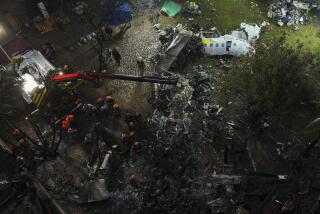Latin American Countries Try to Improve Flying-Safety Record
- Share via
CARACAS, Venezuela — The Boeing 727 was approaching Simon Bolivar International Airport near the end of a routine flight when a blip appeared on the radar screen.
To veteran pilot Rafael De Lima, ferrying 140 passengers on the Viasa flight from Bogota, Colombia, it was not especially alarming. But as he cut through the afternoon skies at about eight miles a minute, he radioed the airport control tower to inquire.
There was no response. Then a warning gauge on the cockpit instrument panel flashed, and an alarm sounded. A collision was imminent.
“Climb immediately! Climb immediately!” a taped message ordered the pilot.
De Lima swerved up and to the left, the standard evasion maneuver. As he did, he saw an Air France Airbus rising from takeoff straight at him.
It was so close that he saw the face of the Air France pilot, who pitched his own plane into a dive.
“Four more seconds and we were all dead,” said the 51-year-old captain. “If I had done nothing, his plane would have split mine in two.”
Incidents like the near miss on March 8, 1996, are rare anywhere in the world. But flying in Latin America remains more dangerous statistically than in North America, Asia or Europe. And De Lima, whose airline has since gone out of business, says near accidents are not as rare as passengers may believe.
Much of the continent is mountainous, including the areas around the airports for many capitals and other major cities. Aviation officials acknowledge a history of shortcomings in aircraft maintenance and airport facilities. Last year, half a dozen commercial jets crashed in Latin America.
Partly in response to scrutiny by the U.S. Federal Aviation Administration, which found safety oversight lacking in most of the region’s countries, many improvements are underway.
De Lima blamed his near miss on inexperienced, overworked military air traffic controllers who had recently taken over in Caracas for civilians in a labor dispute.
Less lucky were the passengers on an Aeroperu flight last October, when ground crews cleaning the aircraft failed to remove adhesive tape that had been placed over its altitude sensors. Because of that oversight, the Boeing 757 plunged into the Pacific Ocean while groping blindly, in dense fog at midnight, for a way back to the airport. All 70 aboard died.
A Flight Safety Foundation study found that Latin America had the world’s highest rate of crashes during attempted landings. The 32 accidents per million flights--by planes of all types from 1984 through 1993--is three times the world average and nearly eight times the U.S. average.
According to a Boeing Corp. study covering 1986-96, large commercial jet crashes in Latin America happen at an average of 4.5 per million flights--three times the world average and nine times the U.S. average.
The FAA focused on Latin America and the Caribbean in its compliance program, which examines whether countries are meeting international standards for overseeing air safety. It gives three possible ratings: a satisfactory Category 1, a conditional Category 2 and an unsatisfactory Category 3. Airlines based in Category 3 countries generally are barred from flying to the United States.
In the latest FAA list, only 13 of the 30 rated countries in the region--or 43%--earned a place in Category 1. By comparison, 93% of European countries and 69% of Asian countries were rated Category 1. Only Africa fared worse than Latin America, with just two of the eight African countries studied earning the top rating.
The FAA looks at how a country’s aviation safety agency monitors the training and qualifications of pilots, ground crew, mechanics and other airline personnel. The agencies also must ensure that manuals, charts and records at airlines are up to date.
The FAA doesn’t disclose specifically why it rates a country poorly, and the affected governments aren’t eager to do so. But a country’s response to a less than satisfactory rating sometimes indicates where problems may lie.
After being rated Category 2, Venezuela repaved the main runway at Simon Bolivar Airport for the first time in 22 years. Civilians are returning to air traffic control towers, and the country’s main aviation law is being updated. Venezuela has grounded all flights by one airline, Zuliana de Aviacion, for lack of compliance with maintenance and safety procedures.
Colombia, also in Category 2, improved its national system of radar beacons. Bolivia just finished a $43 million renovation of John F. Kennedy Airport at La Paz and turned management over to a U.S. aviation services company, Airport Group International Inc.
The FAA program has fostered resentment in the region. Some critics contend the United States is using it as leverage to earn more business for American carriers and to sell more U.S.-made planes.
But many officials concede it has forced their countries to pay badly needed attention to air safety.
“No one these days, when we meet among ourselves, would contest the program,” said Henry Lord Boulton, who is president of the Venezuelan airlines Servivensa and Avensa and head of the five-nation Andean Airline Assn. “We admit we’ve been lax, inefficient, immature.”
Abel Enrique Jimenez, director of Colombia’s civil aviation agency, acknowledged his country, like others, for years ignored FAA pleas to uphold international norms for aviation safety.
In the 1980s, “many of our countries were going through a process of slow institutional weakening of our civil aviation authorities which in the end affected our capacity of vigilance and control,” Jimenez told an airline safety conference in Cartagena, Colombia, in February.
Among the region’s weaknesses is a radar system that covers only airports in large cities and is virtually nonexistent for large stretches of Amazonian jungle and desolate mountain ranges.
Some fleets also have aging jets. Some airports have outdated navigation aids and inadequate inspection and maintenance facilities and procedures.
U.S. pilots complain that some air traffic controllers have problems speaking and understanding English, the international language of flying.
For all that, safety issues now tend to be addressed, not neglected. Barry Valentine, the FAA acting administrator, said flying in Latin America “is certainly much better today than it was several years ago, and it continues to improve.”
Boulton, 67, with a lifetime’s experience of flying in his family’s company, says new technology has helped to make flying safer.
While many passengers may be unaware of the specific problems in a given country, travelers to Latin America see safety as an issue.
“Normally, the first three things people ask for are: quality [of the tour], their personal safety and aviation safety,” said Stevie Borges, owner of SBA Nature Expedition.
More to Read
Sign up for Essential California
The most important California stories and recommendations in your inbox every morning.
You may occasionally receive promotional content from the Los Angeles Times.













